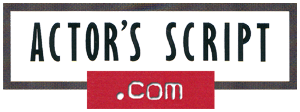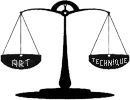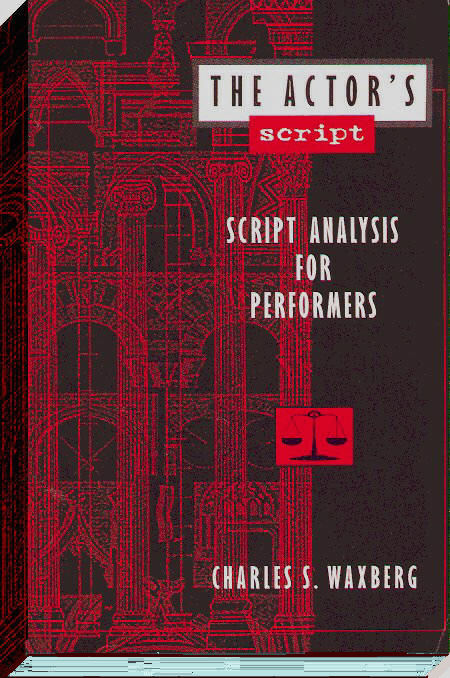
is a balanced creation of
Art and Technique


Published by Heinemann Books in 1998, The Actor's Script is currently in its eighth printing and available at most drama book stores, the publisher: http://heinemann.com/shared/products/07031.asp
From the Introduction: copyright Charles S. Waxberg, no reprints without permission.
You can tell very little about a stranger who's reading a book or a magazine. Perhaps you make general assumptions from the subject matter, but little else. However, if you see someone reading a playscript, you inevitably think they are in theatre or taking a dramatic literature course because very few people read plays for pleasure. There is a reason for this: plays are meant to be performed, not read. Until a script is married with the artistic contributions of actor, designer, technician, director, and finally audience, it is unfinished. A novel completes its circle with one reader as a painting does with one viewer. But the performing arts require collaborative contributions and for this reason, are intentionally incomplete. And since, as works of writing, they are incomplete, they are rarely read for pleasure by everyday people.
The first contact an audience has with a play is the last stage of its development. They hear about it, see an advertisement, get an invitation, receive a recommendation from friends, or similar publicity. These are the final ingredients but the genesis of that play began in the mind of a playwright. An idea came from some unidentifiable place we call inspiration, and seeded the mind. All life begins with seeds, and plays are recreations of life on an artistic level.
The play was born with that seeded idea, and evolved first into a script. Then the script was collaborated on by other artists, and grew to production. Every artistic choice, technical invention, and dramatic interpretation was created to bring that idea to life in the fullest, most communicative form possible. The script is the tangible life of that seed and everyone involved uses it as a reference just like everyone on a new building site refers to a blueprint.
But what exactly is a script? The script is nothing less or more than a sequential listing of actions. Actions are anything done and the script lists these actions, in sequence, that will result in the completed work brought to life by all the artists involved. Although there may be descriptions of location and character, this is not crucial especially in 20th Century drama. A script is no more a play than a blueprint is a house, or a recipe is a cake.
Examine the beginning of Harold Pinter's Betrayal. Pinter begins the play with the briefest description necessary to communicate the "mise-en-scene": time and location:
Pub. 1977. Spring. Noon.
If it were a novel, he may have described in great detail the appearance and atmosphere of the pub--the stained glass windows, the dark oak tables, the presence of music and din, or the class and demeanor of the other patrons. But Pinter acknowledges that these details are design and directorial interpretations and the audience will see them. A playwright chooses as few words as possible to convey an idea.
(Playwrights like Shaw or O'Neill went to great lengths to describe the many details of locale and character appearance, but this was when printing-press paper became plentiful and people were reading plays for pleasure. Playwrights wrote with this in mind.)
Then the play truly begins, or rather, the sequence of actions start:
1st action: Emma is sitting at a corner table. (or "Emma sits.)
2nd action: Jerry approaches with drinks. Then specifying more the nature of what he is carrying in order to illuminate character efficiently, a pint of bitter for him, a glass of wine for her.
3rd action: He sits.
4th action: They smile,
5th action: toast each other silently,
6th action: drink.
7th action: He sits back and
8th action: looks at her.
There is an action in dramatic writing that is so common--so universal--that there is a shorthand for it: So-and-so says. This is recognized by the name centered over the dialogue, or preceding it with a colon:
9th action: (Jerry says,) "Well..."
10th action: (Emma says,) "How are you?" Etc...
Often, you will find a non-specific action Pause or Beat which means that the playwright is giving you a period of time before the next action begins. This is not an indication to "wait," but more of a "free space" to fill with the action that serves your character or your production best.
So basically, a script is no different than a good recipe. (Or for that matter, a bad script, a bad recipe.) Take eggs, flour, water, yeast, and sugar (the ingredients), mix, let it rise, do this, do that (the actions), and you get bread. Take a 16th century Danish castle, a prince, his uncle/stepfather, a ghost, a girlfriend, some buddies etc. (the ingredients), do this, say that, kill them (the actions), and you get Hamlet. It is no less or more a sequential listing of actions and ingredients than a blueprint, a dress-pattern, a computer program, DNA, travel directions, dance steps, or any instruction manual.
However, some instruction manuals are easier than others: One could wager that no one reads the directions on a tube of toothpaste except for those die-hards who must read something--anything--while in the bathroom. Who listens to the "how to fasten seat-belts" directions on an air-flight? You might peruse the instructions to a new toaster-oven only for details that explain its features. Those that come with a new VCR are studied and after a while, if the owner is lucky, are understood (or they join the ranks of blinking digital clocks across the country). The computer on which this book is being written came with an instruction manual. And the programs that "instruct" the computer what to do, each came with instruction manuals. In order to understand those instruction manuals, I purchased some book instruction manuals to help me understand those instruction manuals. And I still don't get it...
The more complex the item or process explained in the instruction manual, the more complex the instruction manual must be. The more complex the instruction manual, the more difficult it is to understand.
Plays are about the human condition. They use human behavior to demonstrate a unique view of this human condition. And there is arguably nothing more complex than our species and its societies. A play attempts to present one facet--one illuminating insight--of the world in which people live and have lived. And to recreate life, even one facet of it, is an extremely intricate and subtle task. The script is the instructions--the artist's DNA--to recreate this life, and cannot merely be read like a book. It must be studied. It's actions are deliberately unspecific. Exactly how does Emma ask, "how are you?" How long does she sit before Jerry enters? What are they doing during the "Pause?" Even with the elaborate descriptions of Shaw or the specific stage-directions of Arthur Miller, the latitude--and necessity--for interpretation is enormous.
The more actors knows about all scriptual elements, the better their choices. The actor who understands play structure will be able to build the most powerful climax and create thematic completion. The actor who understands psychological motivation will best create believable, stirring characters. The actor who understands the playwright's process will best be able to fulfill it's ideas and inherent theatricality. The more versed actors are in reading scripts, the more adroit they will be at making strong, powerful choices that illuminate the play and entrance an audience.
This book examines the most universal elements in scripts so that actors can intelligently interpret and use them. When you finish reading here, you will be able to pick up any script and pull the most useful elements, enliven the largest statements, and recognize the playwright's subtle signposts that point the way to strong theatrical conflict and rich performance.